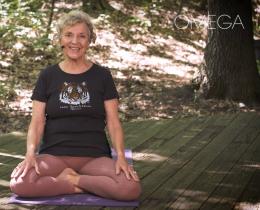According to the Yoga Service Council, yoga service is defined as the intentional sharing of yoga practices that support healing and build resilience for all—regardless of circumstances—and are taught within a context of conscious relationship and rooted in self-reflection and self-inquiry.
An important distinction with yoga service is that it is not defined by who is served, but rather by the way it is offered. Anyone can be the recipient of yoga done in the spirit of these principles:
- Teaching yoga in skillful and appropriately adapted ways
- Cultivating a state of “conscious relationship” with others
- Engaging in ongoing self-reflection and self-inquiry
Here's how this approach can work at work.
Yoga in Service of Community Health
Elizabeth Jackson is an experienced public health professional whose work includes leading clinical and operational quality improvement initiatives with community health centers in Massachusetts and working with partners in Africa, Asia, and Latin America to strengthen health systems.
“My lens is indeed public health and community-oriented, and my yoga certification in integrated yoga therapy shapes my orientation as well,” she says. “I tend to think about, and act on, the following: identify populations that would especially benefit from yoga and complementing mindfulness-based practices, remove barriers of accessibility by bringing yoga to 'them,' and then tailoring the practice to meet students and participants where they are.”
In practice, it might look like bringing yoga to underserved communities in public health centers, schools, or libraries in a way that those who attend feel welcomed and can access the benefits of the practice.
Susan Lovett is the founder and director of Hands to Heart Center, which brings yoga to people living with poverty and trauma.
“As a social worker with a 20-year careering focusing on low-income youth and families with trauma, I am always looking for resources and interventions for my clients,” she said in an interview. “There are many unmet needs in the low-income communities of color where I work. There are significant health disparities, lack of access to health and wellness resources, pervasive violence in some neighborhoods, high rates of unemployment, and a deficit of affordable housing. While yoga can’t affect all of those issues, it can certainly impact some of them, along with strengthening communities.”
Emerging science shows how effective yoga is at alleviating depression, stress, anxiety, and trauma and many physical health conditions. Bringing the practice to all parts of a community, especially those areas without access to it any other way, is a great benefit to the overall health of a community.
Modeling the Yoga Service Principles in Clinical Settings
One way to think about incorporating the principles of yoga service into your therapy practice is to consider a shift in outlook from us/them to we, says Melody Moore, a clinical psychologist, yoga teacher, and author, who is founder and president of the Embody Love Movement Foundation, a nonprofit whose mission is to empower girls and women.
“I don’t know about everyone else, but in my PhD program in clinical psychology, I was trained, in sometimes subtle ways, to be on the ‘right’ side of the proverbial, and sometimes literal glass,” she said. “I was trained to call those seeking support for their suffering as ‘the patient,’ and to offer a diagnosis, which, although at times can be helpful, can also feel stigmatizing and create a sense of separation.”
She says one way that she has incorporated the principles of yoga service in her private practice is taking an attitudinal shift and being with her clients in ways that allow for them to feel her true empathy and presence.
“This shift to seeing clients as humans, just like us, who are doing the brave work of svadyaya [self-study], just like us, allows us to cocreate a resonance between us that impacts both of us,” Moore said.
Moore makes it a point to model her own practice by makings sure she feels centered, grounded, oriented, and contained, or in other words, self-regulated.
“When I feel touched or awakened by something happening or not happening in session, I find my deep breath, I locate myself into present awareness in my own body, and I orient to the moment-by-moment experience that is occurring,” she said. “Using these tools, I am much less likely to be reactive, to act out of unconsciousness, or to cause potential harm to clients.”
Bringing Yoga to the Classroom
Argos Gonzalez is a teacher, lecturer, and mindfulness and yoga instructor who has been teaching high school in the Bronx for a decade and a half. He also teaches pre-service and in-service teachers at Hunter College School of Education.
Gonzalez says he was always looking for ways to improve his connections to and relationships with his students. Thanks to yoga service, he learned to pause, reflect, and bring the best of himself into the classroom. To cement the practice in himself, he became certified through both Mindful Schools and Little Flower Yoga so he had a solid foundation of yoga service.
“When we come to classrooms, we bring all this stuff with us,” Gonzalez said. “We have to remember that the children are younger and smaller than us. They depend on us, so we need to be conscious of what we bring as teachers. It’s hard to be present to our own lives—as a working parent I need to also find time to be present to my own children. And then I’m at work with 30 kids who are vying for my attention. Giving them attention is a big deal, especially when combined with kindness, compassion, and taking a beginner’s mind, which means just being curious about each individual child.”
He noticed significant changes when he was willing to really listen to his students and give them his full attention.
One of the biggest hurdles was getting over the "weird" factor. As an English teacher, it’s not the norm to bring yoga and mindfulness into the classroom. But he made it work because of the relationships he had built and because he did the practices, too, which helped build trust.
“It’s all yoga—meeting challenges using inner resources to support the work. I would model it for them and explore it in the classroom,” he said.
Bringing yoga to a classroom can happen in a number of simple ways from making time for stretch breaks, a few deep belly breaths, or short pauses from work, to setting up "peace corners" or "mindful corners" in the room with blankets and books about mindfulness where kids can go to take a break. Young children and teens will benefit from different approaches.
Ultimately, living your life in alignment with the principles of yoga service can allow you to share the benefits of yoga in the workplace, whether you're leading a class or simply modeling practices for people to live a healthier, happier life.



